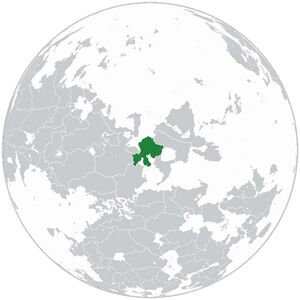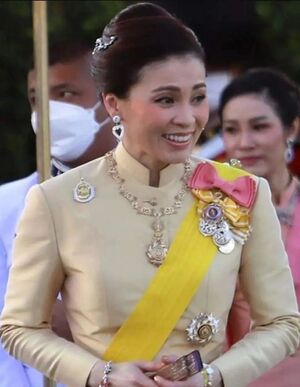The Cape Bay: Difference between revisions
No edit summary |
No edit summary |
||
| Line 85: | Line 85: | ||
Aljian and Common are the 2 official widely used languages of the country. Any sign, advertisement, tv show, movie or song would usually been in one or both of these languages. Aljian is a native language of the Aljiic family (of which it is the biggest), other Aljiic languages include Koroa and Dosoa and many more dead languages. Aljian is polysynthetic language and is ranked as a Level 4 difficulty language, making it very confusing for Common speakers for both cultural and linguistic reasons. Aljian has around 120 million speakers world wide and is a mandatory language in most Bayian schools. Common was introduced through Riamese colonisation and has since become another staple language of the nation. It is also a mandatory language but in The Cape Bay it only has around 70 million speakers. One is able to get around in either language but be aware of many other minority languages you may here in the country. Arabic and Cape-Gabrielt are also languages spoken in many parts due to ethnic minorities that arrived through other mean throughout history. | Aljian and Common are the 2 official widely used languages of the country. Any sign, advertisement, tv show, movie or song would usually been in one or both of these languages. Aljian is a native language of the Aljiic family (of which it is the biggest), other Aljiic languages include Koroa and Dosoa and many more dead languages. Aljian is polysynthetic language and is ranked as a Level 4 difficulty language, making it very confusing for Common speakers for both cultural and linguistic reasons. Aljian has around 120 million speakers world wide and is a mandatory language in most Bayian schools. Common was introduced through Riamese colonisation and has since become another staple language of the nation. It is also a mandatory language but in The Cape Bay it only has around 70 million speakers. One is able to get around in either language but be aware of many other minority languages you may here in the country. Arabic and Cape-Gabrielt are also languages spoken in many parts due to ethnic minorities that arrived through other mean throughout history. | ||
==History== | ==History== | ||
'''Early History (112BCE - 14th Century AD)''' | |||
The origins of the native people of The Cape Bay remain mysterious and unable to be traced but their history on the land dates back to 2,000BCE. Books, poems and other literature has been found as early as this, however it is largely indecipherable to us today. The earliest settlement is the ancient town of Alsiyara on the southern island of the country founded in roughly 1932BCE. This is considered the first point of settlement and one of the oldest in the area. Later exploration would begin a few decades later going throughout the Adelian Peninsula and through to the north of the country. Throughout history the Aljians were largely isolated, even from each-other, developing different ways of speaking and in extreme cases entirely different languages. However, contact with Gabrielt groups to the west and north and Arabian influence to the south due to trading, the language and culture adopted many parts of these cultures and languages with many loan sounds, words and customs. | |||
Politically, most the south was all part of the Chushga (춧스가) Kingdom (772AD-14???) while the North and the rest of the country were rules by smaller nations and city states such as Seycuta, Akchaya and Quang, which are all prominent cities today. Many of these places had brief spatters but majorly stayed out of each others way as each area was important to the other and a disruption of this balance was going to be damaged. Nonetheless the city of Tayusa managed to get itself a foothold in the north ---- Work in progress | |||
==Geography== | ==Geography== | ||
==Government== | ==Government== | ||
Revision as of 19:32, 17 August 2022
The Royal United Territories of The Cape Bay Aso Naegkana e'Qinquao Zheomeoko Beomyo Qeoseo | |
|---|---|
|
Flag | |
| Motto: In The Name Of Our Gods We Prevail | |
| Anthem: The Skies of Purity | |
| Location | Bordering the Rie lake, Sudanic Ocean and Rimidic Ocean |
| Capital | Floria |
| Official languages | Aljian, Common |
| Recognised national languages | Aljian, Common, Dosoa |
| Recognised regional languages | Aljian, Common, Dosoa, Hebrew, Chinese, Japanese, Koroa, Arabic |
| Ethnic groups (2017) | 54% Aljiic
19% Foreign 15% Gabrielt 12% Arab |
| Religion (1994) | No Official Religion |
| Demonym(s) | Bayian |
| Government | Royal Democratic Republic (Constitutional Monarchy) |
• Queen | Saeyeo Seona-Mai-Quo |
• Prime Minister | Deji Twaereo-Qang-Hua |
| Legislature | Parliament |
| The Highness | |
| The Grace | |
| Independence from the Riamese Empire | |
| Population | |
• 2021 estimate | 114,231,827 |
• Density | 168.757724637/km2 (437.1/sq mi) |
| GDP (nominal) | 2021 estimate |
• Total | 1.7T |
• Per capita | $15,654 |
| Gini (2021) | 52.8 high |
| HDI (2020) | 0.876 very high |
| Currency | Jaeseol (Jaysol (JSL) |
| Time zone | UTC - 2 |
| Date format | DD/MM/YY |
| Driving side | right |
slay
Etymology
The name 'Cape Bay' refers to the bay of which the capital city, Seozhenahai, is located. In this bay exists a cape, in the geographical sense, which is what the city is named after. As the knowledge of this land grew the people of Riamo kept the name for their original colony, so the name Cape Bay stuck and now refers to the whole country instead of just the small area in which the name originally referred to.
Language
Aljian and Common are the 2 official widely used languages of the country. Any sign, advertisement, tv show, movie or song would usually been in one or both of these languages. Aljian is a native language of the Aljiic family (of which it is the biggest), other Aljiic languages include Koroa and Dosoa and many more dead languages. Aljian is polysynthetic language and is ranked as a Level 4 difficulty language, making it very confusing for Common speakers for both cultural and linguistic reasons. Aljian has around 120 million speakers world wide and is a mandatory language in most Bayian schools. Common was introduced through Riamese colonisation and has since become another staple language of the nation. It is also a mandatory language but in The Cape Bay it only has around 70 million speakers. One is able to get around in either language but be aware of many other minority languages you may here in the country. Arabic and Cape-Gabrielt are also languages spoken in many parts due to ethnic minorities that arrived through other mean throughout history.
History
Early History (112BCE - 14th Century AD)
The origins of the native people of The Cape Bay remain mysterious and unable to be traced but their history on the land dates back to 2,000BCE. Books, poems and other literature has been found as early as this, however it is largely indecipherable to us today. The earliest settlement is the ancient town of Alsiyara on the southern island of the country founded in roughly 1932BCE. This is considered the first point of settlement and one of the oldest in the area. Later exploration would begin a few decades later going throughout the Adelian Peninsula and through to the north of the country. Throughout history the Aljians were largely isolated, even from each-other, developing different ways of speaking and in extreme cases entirely different languages. However, contact with Gabrielt groups to the west and north and Arabian influence to the south due to trading, the language and culture adopted many parts of these cultures and languages with many loan sounds, words and customs.
Politically, most the south was all part of the Chushga (춧스가) Kingdom (772AD-14???) while the North and the rest of the country were rules by smaller nations and city states such as Seycuta, Akchaya and Quang, which are all prominent cities today. Many of these places had brief spatters but majorly stayed out of each others way as each area was important to the other and a disruption of this balance was going to be damaged. Nonetheless the city of Tayusa managed to get itself a foothold in the north ---- Work in progress


